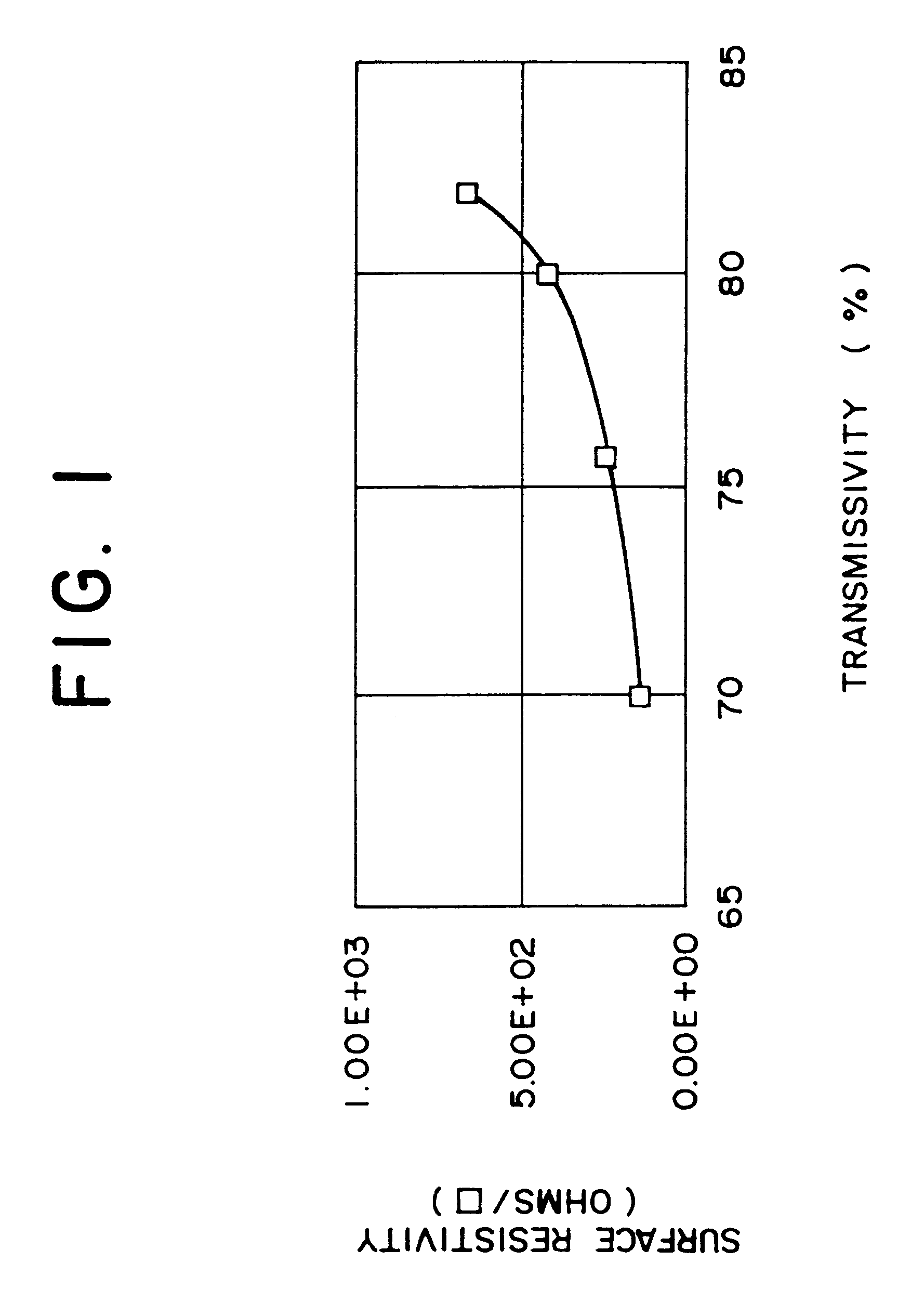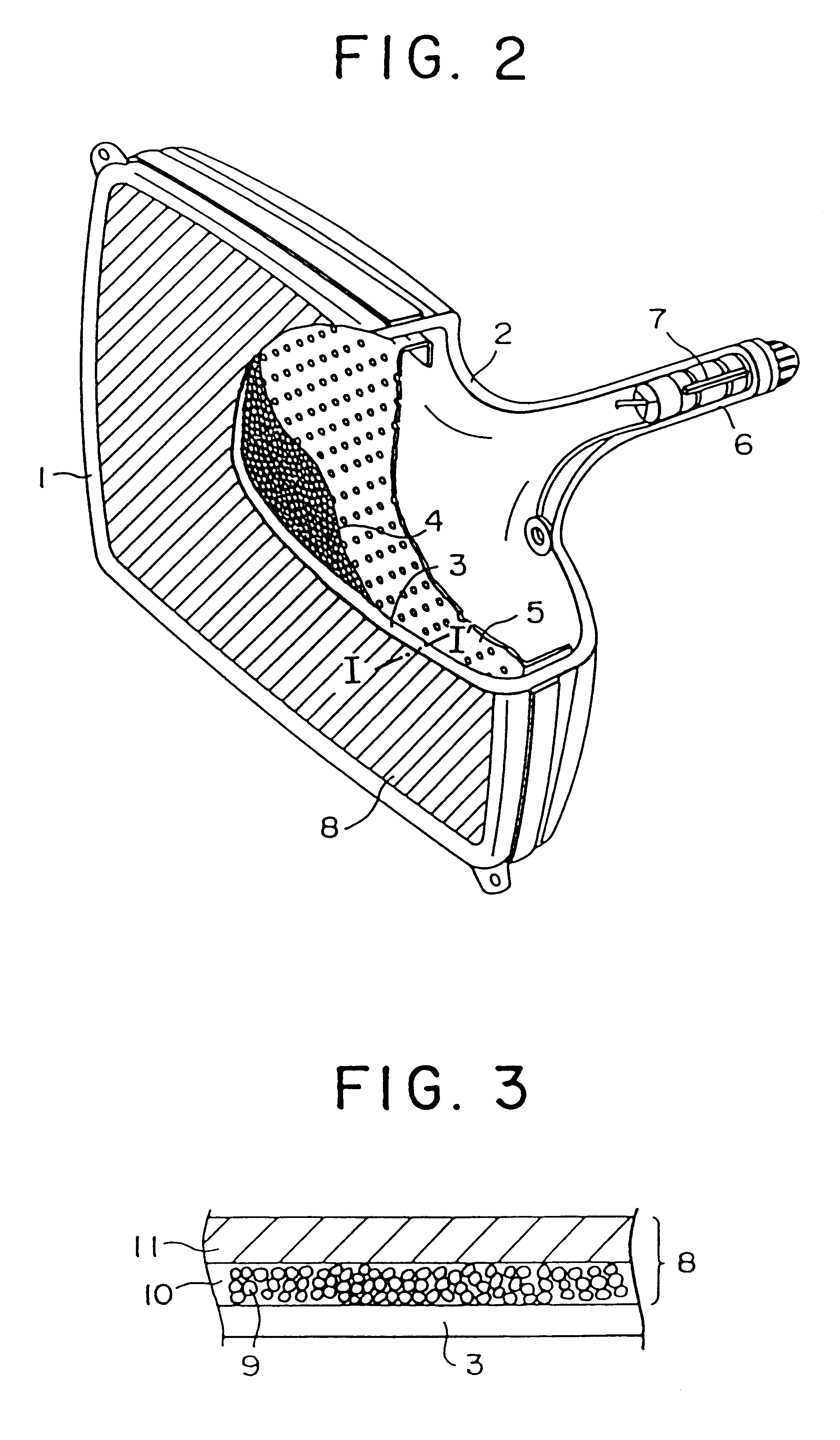Method of fabricating conductive anti-reflection film for a cathode ray tube
a technology of anti-reflection film and cathode ray tube, which is applied in the manufacture of tubes/lamp screens, optical elements, instruments, etc., can solve the problems of high investment cost of the machine, adversely affecting the electronic unit disposed therearound, and inability to prevent aef from taking pla
- Summary
- Abstract
- Description
- Claims
- Application Information
AI Technical Summary
Benefits of technology
Problems solved by technology
Method used
Image
Examples
first and second embodiments
0.5 g of particles of a silver compound such as Ag.sub.2 O, AgNO.sub.3, or AgCl was solved with 100 g of water. Thus, a first solution was prepared. 5% by weight of 3-glycidoxypropyltrimethoxysilane was added to a silicate solution composed of 8 parts by weight of methyl silicate, 0.03 parts by weight of nitric acid (conq), 500 parts by weight of ethanol, and 15 parts by weight of water. Thus, a second solution was prepared. Likewise, 30% by weight of 3-glycidexypropyltrimethoxysilane was added to a silicate solution composed of 8 parts by weight of methyl silicate, 0.03 parts by weight of nitric acid (conq), 500 parts by weight of ethanol, and 15 parts by weight of water. Thus, a third solution was prepared.
Thereafter, the outer surface of a face panel (17-inch panel) of a cathode ray tube that has been assembled was buffed with cerium oxide so as to remove dust and oil. Next, the first solution was coated as a first coat film on the outer surface of the face panel of the cathode r...
third and fourth embodiments
5% by weight of heptadecafluorodecyltrimethoxysilane as solid content equivalent to SiO.sub.2 as shown in Table 2 was added to a silicate solution composed of 8 parts by weight of methyl silicate, 0.03 parts by weight of nitric acid (conq), 500 parts by weight of ethanol, and 15 parts by weight of water. Thus, a first solution was prepared. Likewise, 30% by weight of heptadecafluorodecyltrimethoxysilane as solid content equivalent to SiO.sub.2 as shown in Table 2 was added to a silicate solution composed of 8 parts by weight of methyl silicate, 0.03 parts by weight of nitric acid (conq), 500 parts by weight of ethanol, and 15 parts by weight of water. Thus, a second solution was prepared.
Next, as with the first embodiment, each of the first and second solutions was coated on the first coat film formed on the outer surface of the face panel (17-inch panel) by the spin coat method in the same manner as the first embodiment. Thereafter, the first and second coat films were sintered at ...
first embodiment
As compared examples, each of third and fourth solutions of which heptadecafluorodecyltrimethoxysilane is added as solid content equivalent to SiO.sub.2 as shown in Table 2 was coated on the first coat film by the spin coat method in the same manner as the Thus, second coat films corresponding to the third and fourth solutions were formed. Thereafter, corresponding to the third and fourth solutions, the first and second coat films were sintered at a temperature of 210.degree. C. for 30 minutes.
Next, the panel resistance, surface resistance, and film hardness of the conductive anti-reflection films according to the third and fourth embodiments and the fourth and fifth compared examples were measured in the same manner as the first embodiment. In addition, a hot water dipping test and a chemical resistance test for these conductive anti-reflection films were performed. In the hot water dipping test, after the face panel was dipped in tap water at a temperature of 80.degree. C. for 60...
PUM
| Property | Measurement | Unit |
|---|---|---|
| Temperature | aaaaa | aaaaa |
| Pressure | aaaaa | aaaaa |
| Length | aaaaa | aaaaa |
Abstract
Description
Claims
Application Information
 Login to View More
Login to View More - R&D
- Intellectual Property
- Life Sciences
- Materials
- Tech Scout
- Unparalleled Data Quality
- Higher Quality Content
- 60% Fewer Hallucinations
Browse by: Latest US Patents, China's latest patents, Technical Efficacy Thesaurus, Application Domain, Technology Topic, Popular Technical Reports.
© 2025 PatSnap. All rights reserved.Legal|Privacy policy|Modern Slavery Act Transparency Statement|Sitemap|About US| Contact US: help@patsnap.com



